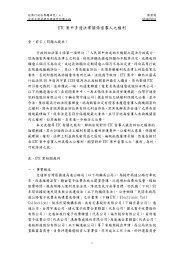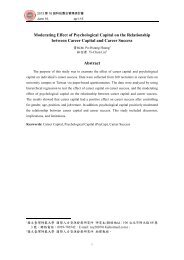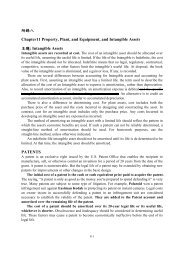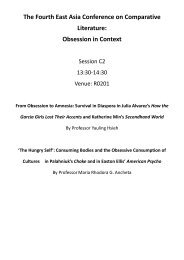The Power of the Pill: Oral Contraceptives and Women's ... - Mail
The Power of the Pill: Oral Contraceptives and Women's ... - Mail
The Power of the Pill: Oral Contraceptives and Women's ... - Mail
You also want an ePaper? Increase the reach of your titles
YUMPU automatically turns print PDFs into web optimized ePapers that Google loves.
power <strong>of</strong> <strong>the</strong> pill 745<br />
timing was related to changes in state laws <strong>and</strong> a growing notion that<br />
young people could make <strong>the</strong>ir own decisions. But how could <strong>the</strong> diffusion<br />
<strong>of</strong> <strong>the</strong> pill have affected pr<strong>of</strong>essional career investments by young<br />
women?<br />
<strong>The</strong> diffusion <strong>of</strong> <strong>the</strong> pill among young, single women may have altered<br />
career decisions through two routes: direct <strong>and</strong> indirect. By <strong>the</strong> direct<br />
effect <strong>of</strong> <strong>the</strong> pill, we mean <strong>the</strong> reduction in <strong>the</strong> cost <strong>of</strong> marriage delay.<br />
<strong>The</strong> pill makes marriage delay <strong>and</strong> thus career investment cheaper, <strong>and</strong><br />
women with greater “career ability” become more attractive marriage<br />
partners. By <strong>the</strong> indirect effect <strong>of</strong> <strong>the</strong> pill, we mean <strong>the</strong> lowering <strong>of</strong> <strong>the</strong><br />
cost <strong>of</strong> a career through <strong>the</strong> marriage market. This effect, in contrast,<br />
operates through a thickening <strong>of</strong> <strong>the</strong> marriage market for those who<br />
delay marriage <strong>and</strong> leads to better matches for career women <strong>and</strong> some<br />
o<strong>the</strong>rs. To simplify <strong>the</strong> discussion, we formally model <strong>the</strong> direct effect<br />
<strong>and</strong> give <strong>the</strong> intuition behind <strong>the</strong> indirect effect. 31<br />
Consider a cohort <strong>of</strong> n women <strong>and</strong> n men, each initially unmarried,<br />
in a two-period context with no discounting. Members <strong>of</strong> each sex agree<br />
on <strong>the</strong> ranking <strong>of</strong> <strong>the</strong> o<strong>the</strong>r in terms <strong>of</strong> marriage partners. Each man<br />
brings Y i (e.g., income), known to all, to marriage. Each woman brings<br />
N j (e.g., nurturing), known to all, to marriage <strong>and</strong> can also contribute<br />
a j through a career; a j is treated as a household public good. We make<br />
<strong>the</strong> simplifying assumption that career investment is not possible if a<br />
woman marries in period 1. Marriage delay reduces utility by l for each<br />
partner. <strong>The</strong> reduction is assumed to be <strong>the</strong> same for all men <strong>and</strong> women<br />
<strong>and</strong> l p l 0 prior to <strong>the</strong> introduction <strong>of</strong> <strong>the</strong> pill. We interpret l as <strong>the</strong><br />
utility lost from abstinence as well as from forgone home production<br />
<strong>and</strong> term l <strong>the</strong> “impatience factor” to encompass both. <strong>The</strong> attributes<br />
Y, N, <strong>and</strong> a are distributed among <strong>the</strong> n men <strong>and</strong> women such that<br />
Y ∼ [Y, Y ], N ∼ [N, N ], <strong>and</strong> a ∼ [a, a], where Y, N, a 1 0. <strong>The</strong> distributions<br />
<strong>of</strong> Y, N, <strong>and</strong> a are known by all participants, <strong>and</strong> each individual’s<br />
attributes are perfectly observable.<br />
Consider a match between male i <strong>and</strong> female j. If <strong>the</strong>y marry in period<br />
1, <strong>the</strong>n <strong>the</strong> male gets N j <strong>and</strong> <strong>the</strong> female gets Y i . If <strong>the</strong>y delay marriage<br />
to period 2 <strong>and</strong> <strong>the</strong> woman invests in a career, <strong>the</strong>n <strong>the</strong> male gets<br />
Nj aj l 0 <strong>and</strong> <strong>the</strong> female gets Yi aj l 0. If aj 1 l 0,<br />
<strong>the</strong>n both benefit<br />
from delay <strong>and</strong> <strong>the</strong> woman will invest in a career in period 1. If, instead,<br />
a j ! l 0,<br />
<strong>the</strong>y marry in period 1 <strong>and</strong> <strong>the</strong> woman has no career. Since<br />
<strong>the</strong>re are no disagreements, we can unambiguously match men <strong>and</strong><br />
women on <strong>the</strong> basis <strong>of</strong> <strong>the</strong>ir value in marriage to <strong>the</strong> o<strong>the</strong>r sex.<br />
Men’s attractiveness to women is completely summarized by Y i .<br />
31<br />
See Bergstrom <strong>and</strong> Bagnoli (1993) for a related model <strong>of</strong> decisions to delay marriage<br />
by men <strong>and</strong> <strong>the</strong> determinants <strong>of</strong> marriage age differences by sex. We consider models <strong>of</strong><br />
single age cohorts <strong>of</strong> males <strong>and</strong> females <strong>and</strong> <strong>the</strong>reby abstract from <strong>the</strong> possible impact <strong>of</strong><br />
<strong>the</strong> pill on sex differences in <strong>the</strong> age at marriage.















